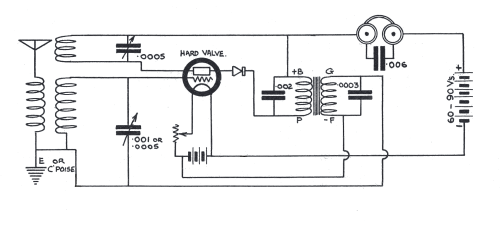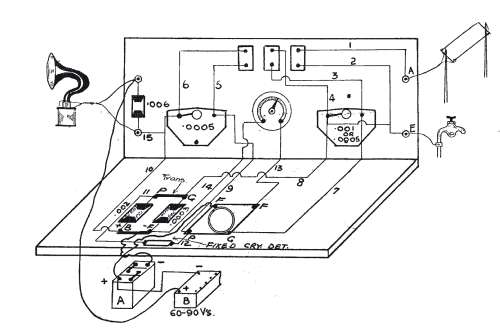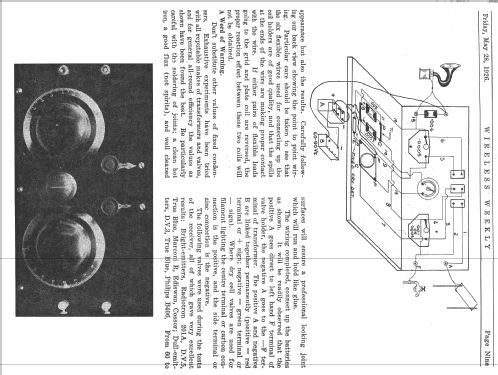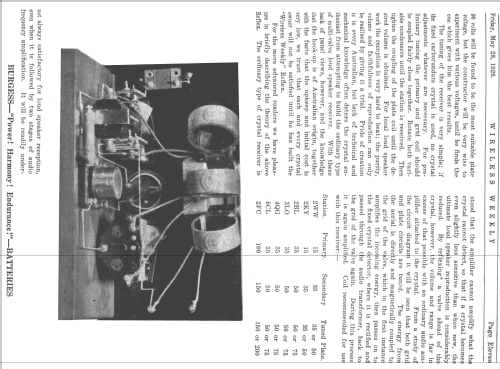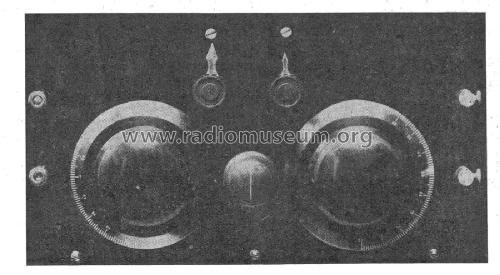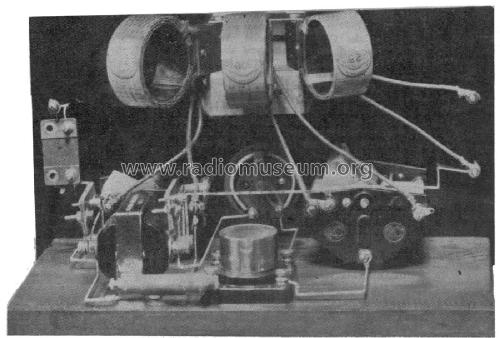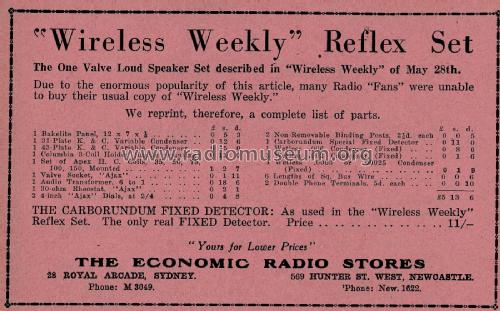Wireless Weekly Reflex
Wireless Weekly Magazine, Sydney
- Country
- Australia
- Manufacturer / Brand
- Wireless Weekly Magazine, Sydney
- Year
- 1926
- Category
- Kit (Parts plus instruction) or building instructions only
- Radiomuseum.org ID
- 332082
Click on the schematic thumbnail to request the schematic as a free document.
- Number of Tubes
- 1
- Valves / Tubes
- 201A
- Main principle
- TRF with diode detector; Reflex
- Wave bands
- Broadcast only (MW).
- Power type and voltage
- Dry Batteries / 6 & 60 Volt
- Loudspeaker
- - This model requires external speaker(s).
- Material
- Bakelite, TUBES VISIBLE
- from Radiomuseum.org
- Model: Wireless Weekly Reflex - Wireless Weekly Magazine,
- Shape
- Chassis only or for «building in»
- Notes
-
The “Wireless Weekly” Reflex
Full Loudspeaker Strength with One Valve“Wireless Weekly” has very much pleasure in presenting to its readers a very efficient one-valve Reflex receiver, which is the result of many months’ experimentation by our Technical Editor. The old proverb that necessity is the mother of invention is without a doubt particularly true with regard to radio apparatus. Realising that a cheap efficient loudspeaker receiver was very much needed, Mr. Slade has spent a considerable amount of time in perfecting this one, which without a doubt, will become very popular indeed.
Before beginning the constructional details, we make one appeal to all readers, whether they be experimenters or broadcast listeners, viz.: Give our receiver a trial before criticising. From the results you will obtain, each and every reader will realise that the heading of our poster has not been exaggerated in the slightest degree. Furthermore, readers who are situated in the provincial towns where local broadcasting is taking place will recognise the folly of using a receiver which employs more valves when entertainment from the local station only is desired. The average crystal user is invariably satisfied with the results he obtains, and usually speaks in glowing terms of the life-like purity which his crystal detecting circuit is capable of. The disadvantages associated with the ordinary type of crystal receiver, however, are rather numerous when one stops to consider the inconveniences which they invariably cause. These disadvantages may be summed up in the following order:-(1) Phones have to be cramped to the ears for long periods.
(2) Only a limited number of persons can listen in at any one time.
(3) Long distance reception is not consistently possible.
(4) Constant readjustment of crystal is invariably necessary.
With the “Wireless Weekly” Reflex Receiver, however, all of the above disadvantages are entirely obviated, without losing the purity of reception which is associated with crystal detection. Even where listeners-in are situated within 200 miles of “A” class stations, phones need not be worn, as a small loudspeaker with a moderately light diaphragm will give excellent volume, so that the whole family may listen to the programmes at any one time.
Disadvantage No. 3 is by no means barred with this receiver, as 3LO, 4QG, and SCL can all be received in Sydney with very excellent phone strength. Disadvantage No. 4 is entirely eliminated by using the new type of Carborundum crystal detector, which is particularly suitable for this hook-up. Six different crystal units were tested in order to be perfectly sure that each one would give exactly the same results. The photographs of the front and back views show clearly the positions of the various components used, and for the beginner the popular back of panel views showing wiring are also given.
“Wireless Weekly” has used an internal mount, three-coil holder, but this is not absolutely essential. The ordinary type with face mounting or a panel plug and two coupling plugs may be used with equal efficiency. Wireless Weekly May 28, 1926, Page 7.The cost of the Kitset without batteries and valve was £5/13/6.
- Price in first year of sale
- 5.68 AUS £
- Mentioned in
- Wireless Weekly (Australia) (May 28, 1926, Page 7.)
- Author
- Model page created by Gary Cowans. See "Data change" for further contributors.
- Other Models
-
Here you find 19 models, 13 with images and 19 with schematics for wireless sets etc. In French: TSF for Télégraphie sans fil.
All listed radios etc. from Wireless Weekly Magazine, Sydney
